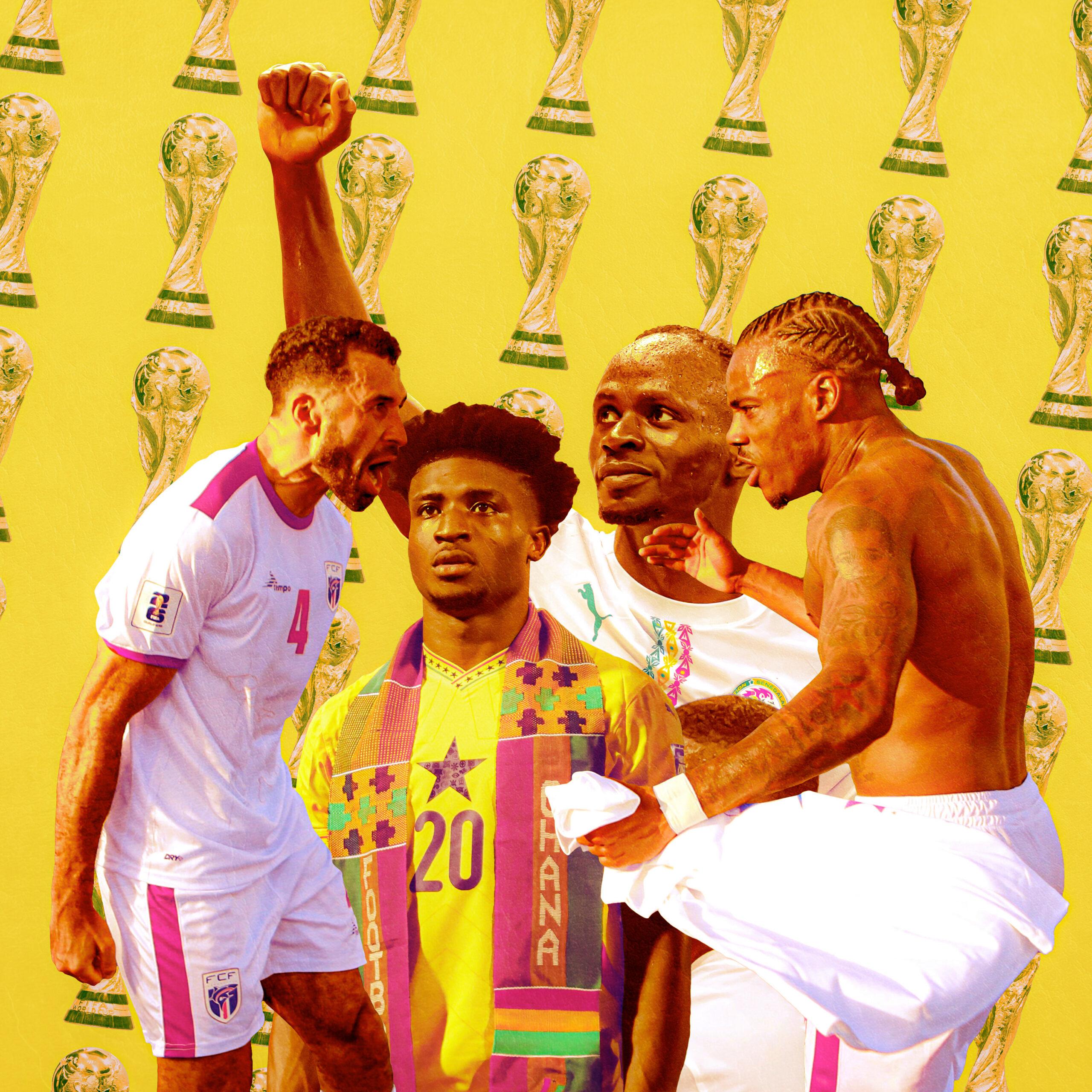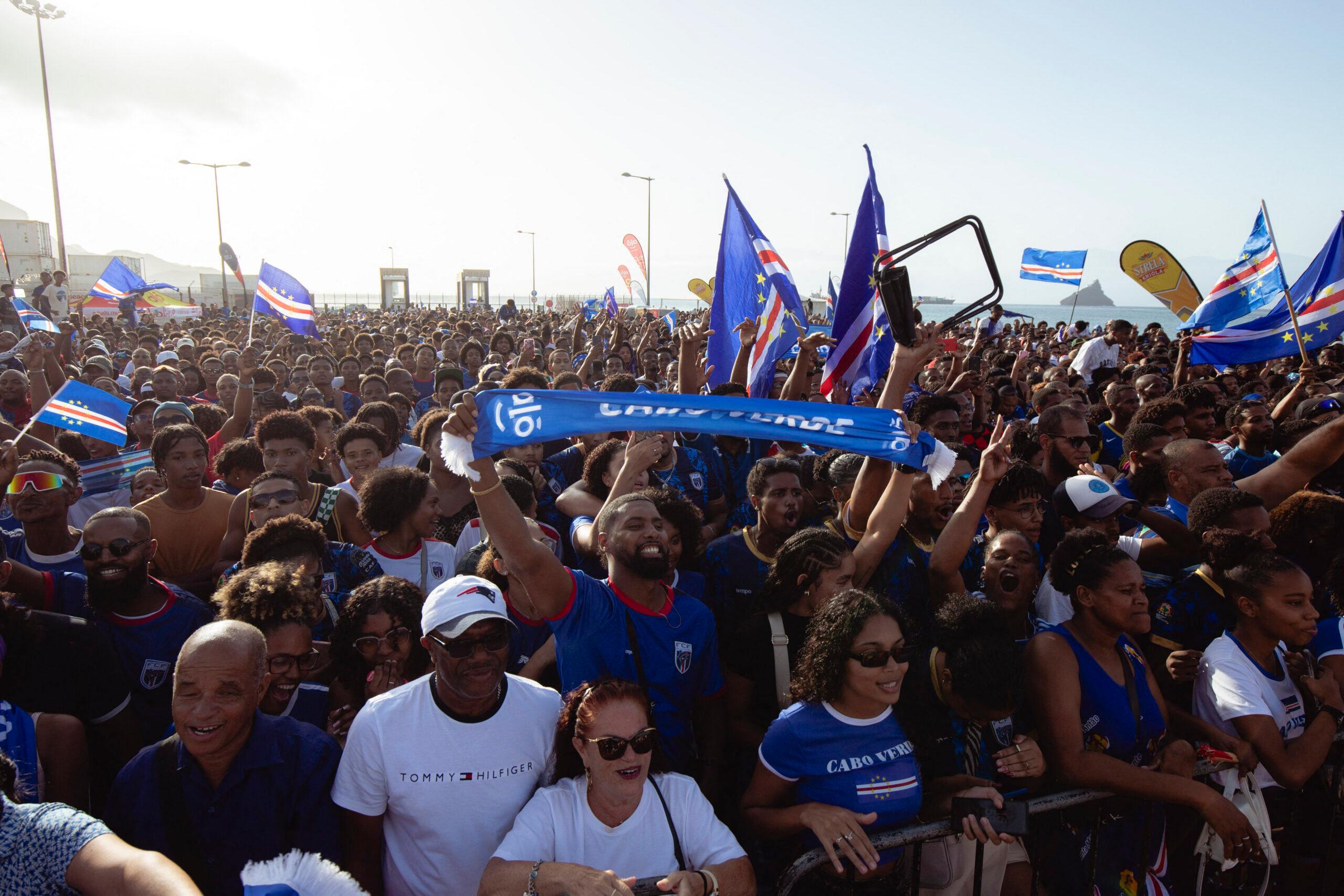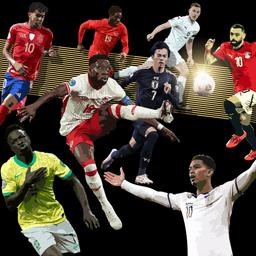
Welcome back to World Cup Countdown—The Ringer’s monthly column previewing the 2026 World Cup, which will be hosted in the United States, Canada, and Mexico. Each month, we’ll cover everything shaping the tournament, from the U.S. men’s national team to the stars and story lines abroad that will define qualifying and the buildup to the opening match. Here’s where we stand 237 days before kickoff.
The Big Thing
African Nations Secure Qualification; Playoff Chaos Awaits
If there’s one thing about the World Cup qualifying process, it’s that every confederation is built different. Europe’s UEFA is the most top-heavy of any region. South America’s CONMEBOL has the most grueling campaign, with 18 matches played over three years. But Africa’s CAF might be the most unpredictable and chaotic of them all. Even with this World Cup’s expanded format that sees nine teams from CAF directly qualify (up from five in 2022), this cycle has had no shortage of drama and story lines.
Let’s start with the shock debutant. Cape Verde, an island nation with roughly 525,000 people (approximately the same as the city of Baltimore), became the second-smallest country by population to ever qualify for a World Cup. I wrote about Cape Verde’s chance to make history last month, and now their 3-0 win against Eswatini on Monday has made it official. Based on Transfermarkt squad value, Cape Verde ranks 19th in Africa and 82nd worldwide. Cape Verde didn’t even qualify for this winter’s Africa Cup of Nations, yet here they are, about to play on the biggest stage possible. The celebratory scenes pitchside and back home in Cape Verde were a sight to behold. José Maria Silva, Cape Verde’s national director of state protocol, told The Guardian that the World Cup qualification could be considered “a defining moment of our nation.” En route to that qualification, Cape Verde topped embattled Cameroon in their group, a team with way more footballing pedigree and talent on paper.

Speaking of Cameroon, the team’s head coach, Marc Brys, has made his ongoing criticisms of the nation’s soccer federation more clear in recent weeks. He accused the federation, led by current president Samuel Eto’o (yes, that Samuel Eto’o), of making qualifying more difficult. Brys reportedly took issue with the federation rejecting a list of coaches to join him on the sideline for Cameroon’s recent game against Mauritius. The tension is heating up as Cameroon prepares for the CAF playoff next month in the hopes of squeaking into the final World Cup field via the intercontinental playoffs. Cameroon will compete in a four-team mini-tournament with DR Congo, Gabon, and Nigeria. (A face-off with the latter would be particularly spicy—two nations that are African footballing royalty!) The winner of that tournament will then compete in the intercontinental playoffs, which take place in March. (More on that process to come in the months ahead.)
I would be remiss not to mention that while Nigeria had to settle for only a playoff spot, they rescued their World Cup campaign in style, winning their final four out of five games. The key difference? Victor Osimhen. The striker missed the first five qualifying matches due to injury. Upon returning for the second half of qualifying, he scored six goals; Nigeria as a whole scored 15 in 10 matches. The Super Eagles could be a problem in the playoffs if Osimhen can stay healthy.
Elsewhere, South Africa clinched qualification for the first time since 2010, when they hosted the World Cup. And Ghana secured its second straight qualification, making it five World Cup appearances out of the last six tournaments. It’s pretty remarkable that this World Cup–bound team featuring two of the Premier League’s best, Antoine Semenyo and Mohammed Kudus, failed to qualify for AFCON, which kicks off in December in Morocco. This is where we’ll transition to the African nation that secured the best-ever finish at a World Cup.
On paper, the African 2026 World Cup team most likely to be the Morocco of 2022 and go on a magical Cinderella run to the semifinals is … well, Morocco again. They have the highest Transfermarkt squad value (15th overall, one spot ahead of the United States) of any team on the continent. Manager Walid Regragui is back after his side upset Belgium, Spain, and Portugal en route to the final four in Qatar. Morocco’s ability to defend without the ball in an organized block and hit opponents in transition is a simple and effective formula for winning tournament soccer matches. PSG’s Achraf Hakimi, PSV’s Ismael Saibari, and Real Madrid’s Brahim connect the team from back to front.
In this cycle, Morocco had one of the easiest qualifying groups but won all eight matches with a +20 goal difference. I suspect that when it comes time to make dark horse and upset picks, people will look elsewhere on the continent and overlook that the best African team is sitting right there in front of us. (Though keep an eye out for Morocco’s North African neighbors, Algeria and Tunisia, who also are headed to the big dance and possess respectable rosters.)
If you played FIFA anytime between 2006 and 2014, you probably played with Ivory Coast at some point. That golden generation of players—spearheaded by Didier Drogba and Yaya Touré—never actually made it out of the group stage in their three World Cup appearances. The country did go on to win the Africa Cup of Nations in 2023 after firing their manager in the middle of the tournament. In the following World Cup qualifying campaign, they didn’t concede a single goal in 10 matches—they’ll be in North America next summer. This version of Ivory Coast lacks the top-end star power of that past generation, but this squad has considerably more depth of players around the top five leagues in Europe. Most notably: Amad Diallo (Manchester United), Evan Ndicka (Roma), Simon Adingra (Sunderland) and Evann Guessand (Aston Villa).
Senegal does possess top talent, but they are aging a bit since the last World Cup, when they advanced to the round of 16 before losing 3-0 to England in a match that was more competitive than the final score indicated. The spine of the defense is still reliable thanks to their solid defensive midfield (Pape Matar Sarr, Idrissa Gueye) and center backs (Kalidou Koulibaly, Moussa Niakhaté). Chelsea’s Nicolas Jackson, Crystal Palace’s Ismaila Sarr, and the legendary Sadio Mané make up most of their goal scoring, but there are questions over where the chance creation and passing range comes from. Senegal is still a major African power, though, and they should be competitive come June.
Egypt will go as far as Mohamed Salah and Omar Marmoush can take them. Before this season, you could make a convincing case that Salah was the best player in the world. And while it’s only been seven Premier League matches this season, Salah has seen a significant dropoff in production. He only has one non-penalty goal. He’s taking fewer shots, touching the ball less often in dangerous areas, and his dribbling stats have fallen off a cliff. Odds would have been stacked against Egypt regardless, but they are in even greater trouble if peak Salah doesn’t return by next summer.
State of the States
This section focuses on the United States men’s national team as it prepares to host the World Cup.
The U.S. is now unbeaten in three consecutive matches against opponents ranked inside the FIFA top 25. Is that statement moderately misleading given the quality of the lineup Japan put out and the absence of Moisés Caicedo for Ecuador? Perhaps. But at this point, the Americans will take small victories wherever they can get them. Mauricio Pochettino made it clear during the September window that he’s not really focused on the results, but avoiding losses to quality opponents never hurts. For a national team that has largely been in disarray for the last 12 months, it was nice to have a window without a puzzling loss or performance.
The USMNT played Ecuador to a 1-1 draw last Friday. Scoring a goal against Ecuador is a solid achievement given that La Tri finished second in CONMEBOL qualifying and conceded just five goals in their 18 matches. The Americans followed the Ecuador draw with a come-from-behind 2-1 victory against Australia on Tuesday night. Midfielder Cristian Roldan (Seattle Sounders) registered both assists, and it’s notable that he’s been called up in each of the last two windows, starting two out of four games. He has potentially won some favor with Pochettino. His call-up in September was the first time Roldan appeared for the national team since the 2023 Gold Cup—a roster which featured very few of the team’s top players.
Both of Roldan’s assists were to Coventry City’s Haji Wright, who made his debut as a starter under Pochettino on Tuesday. Wright’s ability to run in behind, receive the ball in dangerous areas, and shoot with both feet was on full display. The passing vision and movement of Roldan plus the finishing quality of Wright gives Pochettino more options amongst his attackers.
Pochettino opted to play a back three in both matches, which I continue to believe is the optimal decision—if, and only if, he has three center backs he can trust. We still haven’t seen Antonee Robinson feature for the USMNT since last October due to various injuries, and how Pochettino uses Robinson’s wing back–like abilities could be the key to unlocking the Americans’ attack.
In true USMNT fashion, though, it couldn’t be a fully stress-free international window. Christian Pulisic entered the two-week period nursing an ankle injury and came off early against Australia with a hamstring problem. The severity of the injury isn’t yet known, but Pulisic may not be available for the November window when the Americans host Paraguay and Uruguay.
Stock Watch
This section focuses on the shifting fortunes of players, managers, and nations who could play a significant role next summer.
Stock Up: Home Sweet Hampden
Scotland hasn’t qualified for the World Cup in the 21st century. After consecutive home wins last week at Hampden Park against Belarus and Greece, the Scots are potentially one home win away from reaching their first World Cup since 1998. They’re currently tied with group favorites Denmark with two matches left to play. The two sides will face each other in the final group match on November 18 at Hampden. Denmark is likely to hold the tiebreaker, so Scotland will probably need to win that match. The two sides played each other to a scoreless draw in Copenhagen in September. Denmark was the better team based on xG created and percentage of possession, but Scotland will now have a raucous home crowd behind them. Next summer, instead of just cheering for England’s opponent, as is tradition, the Scots might be able to root for themselves. If they do come in second behind Denmark, Scotland is off to the playoff.
Stock Down: Sweden Makes History for the Wrong Reasons
Sweden made history this week when it sacked its national team manager for the first time ever. Consecutive shutout home losses to Switzerland and Kosovo was apparently enough to see the back of Jon Dahl Tomasson.
Sweden has the 11th-most valuable squad in the world, according to Transfermarkt, primarily due to their two strikers, Liverpool’s Alexander Isak and Arsenal’s Viktor Gyökeres. If you’re just naming some guys, you’d probably really like this Swedish team with complementary Premier League regulars like Anthony Elanga (Newcastle United), Lucas Bergvall (Tottenham), and Dejan Kulusevski (also Tottenham, out injured). Yet we’re now four matches into qualifying and Sweden’s chances of reaching North America next summer are slim. Despite all the attacking prowess on paper, Sweden has scored just two goals in those four matches. They now have no chance to finish in the top two in their qualifying group, which means their only path is to be one of the four Nations League playoff teams. They’ll probably be one of 16 UEFA playoff teams vying for the final four spots in March. In the case of Sweden, it really does feel like the whole is less than the sum of the parts.
Stock Up: More Than Just Baseball
Despite being an island nation of just 156,000 people, Curaçao has always produced Major League Baseball talent. Past and present MLB regulars from the 171-square-mile island include Ozzie Albies, Kenley Jansen, Andrelton Simmons, Jurickson Profar, and Andruw Jones. But now the Caribbean country is looking beyond the baseball diamond. Curaçao’s soccer team beat Jamaica 2-0 at home last week to move within one point of the Reggae Boyz at the top of their qualifying group. The two sides will meet again in November in Kingston. The winner of the group will advance directly to the World Cup, while second place is likely headed to the interconfederation playoffs.
Iceland is the current record holder for the least populous nation to ever qualify, and Curaçao has less than half of that population. That means Cape Verde could soon drop to third!
Stock Down: Extreme Ticket Prices for Soccer Fans
The secondary ticket market in America has been a mess for years, and there is no better event for ticket scalpers to try to profit from than the World Cup. It’s a one-off, once-in-a-lifetime (OK, maybe twice) sporting event in the United States, and because FIFA is controlling all of the ticket sales and resales, we’re also at their mercy should we decide to go about purchasing tickets the traditional way. Ordinary and lifelong soccer fans will absolutely be priced out.
FIFA said in September that ticket prices would be as cheap as $60, and while that is technically true, it’s true only for a handful of seats at select games. “Dynamic ticket pricing” is the new corporate buzzword that’s being used to justify these extreme prices. NBC News reported that tickets ranged from $560 to $2,735 for the USMNT’s opening game, and tickets on the resale market are going for considerably higher than that. You can lecture me all you want about supply and demand, but it doesn’t mean I’m not bummed out, and I suspect the average fan feels the same way. My friend Tom Bogert put it well last week:
Stock Up: Another Goal-Scoring Record for the Ageless Ronaldo
Forty-year-old Cristiano Ronaldo scored twice for Portugal in their 2-2 draw with Hungary on Tuesday and broke Guatemalan legend Carlos Ruiz’s record for the most goals scored in World Cup qualifying, with 41. You know what this means: The Ronaldo cycle is now officially in full swing.
Step 1: Portugal gets bounced from a major tournament and we think that’s the last time we’ll see Ronaldo play for his country
Step 2: Ronaldo, somehow, remains on the team and scores a boatload of goals
Step 3: Portugal arrives as one of the favorites to win the next major tournament
Step 4: Ronaldo and Portugal underperform to expectations. Repeat Step 1.
Benching Ronaldo against Switzerland and Morocco in the 2022 World Cup felt like the end. Then the depressing end of Euro 2024 against Slovenia and France really felt like the end. It turns out there may be no end at all. I know Portugal won the Nations League this summer and Ronaldo scored the equalizer, but do we realllyyyy consider that to be a major tournament? Either way, this will be a fascinating story line to watch as Portugal gears up for next summer.
Stock Up: Brazil’s Search for Their Next Superstar
Nineteen-year-old Endrick was assumed to be Brazil’s next breakout superstar when he moved to Real Madrid following the 2024 Copa Ámerica. That hasn’t quite happened. But another teenage prodigy, 18-year-old Estêvão of Chelsea, has been turning in performances for club and country that make him the far likelier breakout candidate right now. Not only did Estêvão score twice for Brazil in a friendly against South Korea last week, but he’s been the shining beacon of an otherwise shaky start to Chelsea’s season. Estêvão scored a last-minute winner against Liverpool just before the international break and has been the Blues’ best attacking player this season. He’s producing almost three shots per match and has tallied nearly a full expected goal plus expected assist per 90 minutes. The wide attackers room is quite crowded for Brazil right now with Rodrygo, Vini Jr., Raphinha, Gabriel Martinelli, and more, but Estêvão is flashing “future best winger in the world” upside already.
Awards Spotlight
Each month, the World Cup Countdown selection committee (me) will highlight some of the best, worst, and strangest moments in the sport.
The Prop Joe “Look the Part, Be the Part” Award: Hervé Renard’s Lucky White Shirt
Hervé Renard has a rich history of coaching at the international level. He’s won the AFCON with two different countries (Zambia, Ivory Coast), led Saudi Arabia to a historic upset of Argentina in the 2022 World Cup, and coached the French women at the 2023 Women’s World Cup. He’s also notorious for his fitted, button-down white shirt that he always wears as a manager. Renard is back with Saudi Arabia and he’ll be coaching them next summer at the World Cup after they tied Iraq 0-0 and qualified for the tournament. Like in 2022, Renard’s squad isn’t nearly as talented as most of the field, but he’s as experienced tactically and motivationally as any manager on the international scene. If he’s donning that iconic shirt on the touchline next June, I certainly won’t be betting against him.
The “Maybe He’s a Striker After All” Award: Mikel Merino
He doesn’t look like a striker. He doesn’t move like a striker. He literally is not a striker. Yet when he’s been asked to contribute goals for club and country in 2025, Arsenal and Spain midfielder Mikel Merino delivers like he’s been playing the position his entire career. Arsenal deployed him as a true striker in the spring due to their injury crisis, and while it wasn’t spectacular, he did score seven league goals and produce more than two shots per 90. Now, playing a hybrid attacking midfielder role for Spain, Merino has six goals in four qualifying matches.
Because Spain gets so much attacking production and shots from its young wide forwards (Lamine Yamal and Nico Williams), they can play a striker who is lighter on shots but helps press and maintain possession. Sounds oddly like the role of a midfielder, no? I don’t think Merino is Spain’s first choice long term, but he’s certainly not a terrible option in a pinch.
Extra Time Notes
- The quickly approaching World Cup draw is set for December 5 at the Kennedy Center in Washington D.C., even though the final six World Cup spots will not be decided until the European and interconfederational playoffs in the spring.
- Qatar beat the United Arab Emirates 2-1 this week to officially qualify for the World Cup. After losing all three of its group matches as host nation in 2022, Qatar will look to improve on that showing in their second-ever appearance in the tournament. UAE will face off against Iraq in November, with the winner earning the Asian place in the interconfederation playoff.
- Fourteen more World Cup spots will be clinched during the November international window, which is the final one of 2025. Three of those spots will come from CONCACAF, where the three group winners will advance. The other 11 will be the UEFA group winners (alongside already-clinched England).
Here are the most important matches during the next window to follow:
CONCACAF group stage:
November 18: Jamaica vs. Curacao
November 18: Costa Rica vs. Honduras
CAF playoffs:
November 13: (probable) Nigeria vs. Gabon
November 13: (probable) Cameroon vs. DR Congo
November 16: Semifinal winners meet
UEFA group stage:
November 14: Poland vs. Netherlands
November 16: Italy vs. Norway
November 17: Germany vs. Slovakia
November 18: Scotland vs. Denmark
November 18: Austria vs. Bosnia and Herzegovina





